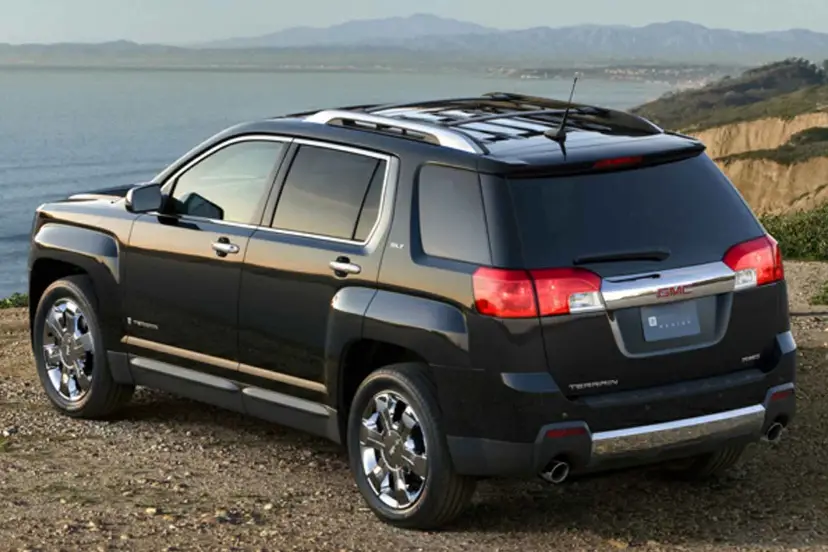
OK class. We’ve got a lot of ground to cover today. However, instead of ground, let’s make that a lot of “terrain to cover,” as in the 2010 GMC Terrain crossover, today’s test vehicle.
The Terrain is the GMC version of the Chevrolet Equinox. Given the proliferation of new models and the fact GMC models are siblings of other General Motors, it takes time for new models to establish brand recognition.
This one is worth getting some of that recognition and should be on your “to consider” list if you’re in the market for a small SUV. Terrain stands out especially for its 4-cylinder “Ecotec” engine that returns an EPA estimated 32 miles per gallon (highway) in the front-wheel-drive version and 29 mpg in the all-wheel-drive version that we tested.
Our test vehicle averaged 26.2 mpg in a variety of driving that included commuting to Boston and local shopping excursions. And that was without using the “Eco” mode, turned on by a button on the center console. That system works by lowering the torque converter lockup to 1,125 rpm. Coupled with an 18-gallon fuel tank, the Terrain can boast of a 576-mile cruising range (front-wheel-drive) or 522-mile range (all-wheel-drive). It also uses regular gas.
The four, mated to a six-speed automatic transmission, was smooth and capable. It didn’t resort to annoying downshifts on hills and had enough oomph for passing, on-ramp accelerating, and lane changes. The Terrain, with 6.9 inches of ground clearance, is a suburban hauler – quiet on the highway, but a bit noisier on rough roads.
Starting price for the Terrain in SLT-1 trim with all-wheel-drive is $29,500. Standard equipment includes six airbags, stability control, anti-lock brakes, tire pressure monitoring system, OnStar, air conditioning, fog lamps, and a rear-vision camera system. GM gets kudos for making the rear-view camera not only standard but also separate from the optional $2,145 navigation system that wasn’t on our test SUV.
Also standard were steering wheel audio controls, automatic climate control, premium Pioneer sound system, heated leather seats, and 18-inch machined aluminum wheels.
Our test vehicle priced out at $32,325 with options, including the sunroof ($795), trailering package ($350), carbon black metallic paint ($195), cargo management system ($245), power programmable rear liftgate ($495) and $745 destination charge. That liftgate can be set to open all the way, making it easy for six-footers to avoid whacking their heads, or only three-quarters of a lift so the gate won’t whack a garage ceiling, or the power feature can be turned off altogether. The adjustment knob is on the overhead front console; plus there’s a power button on the gate itself for lowering.
Mrs. G, not knowing that the carbon black metallic was an optional color, took one look at it and said, “That’s a nice color and a nice paint job with the metal flakes in it.”
Another of the many things GM did right with the Terrain was legroom. There’s plenty for both front and rear-seat passengers. That cuts down on luggage space. The Terrain has 31.6 cubic feet, the same as the Nissan Murano but less than the Ford Edge (32.2), Honda CR-V (35.7), and Hyundai Santa Fe (34.2). Still, there’s plenty of room for most things, and the 60/40 reclining and sliding rear seat folds quickly and almost flat for larger items.
Mrs. G replaced what we always thought was an 8×10 rug during the Terrain’s visit. The old rug was sent off to the thrift shop. It fit in the Terrain with one end poking between the front seats. A quick check with a tape measure showed the old rug actually was 7-feet, 4-inches long. Still, that’s a good length to fit in a small SUV.
At first glance the Terrain looks bigger than its listed 185.3 inches of overall length. That’s 5.4 inches shorter than a Nissan Altima, for example. Part of the initial impression of the Terrain is that it’s immense, partly because of the steep front fascia with trademark GMC logo and three-element black grille set off with a chrome border.
There are plenty of bins and cubbies, including a dashboard-top compartment with a rubber liner and very deep box under the center console armrest.
Our Terrain’s leather upholstery was two-tone charcoal and light gray with red stitching. It looked overly contrasted when the vehicle was empty but nice ‘n homey when the car had a normal amount of “stuff” in it.
The center console also had USB and auxiliary plugs. The center stack is slanted away from the driver, making the steering wheel controls a welcome addition. The upgraded sound system / XM radio has enough options for all. Even though there were 36 possible presets, I enjoyed being able to have my favorite six (3 AM, 2 FM, 1 XM) in the same grouping, not having to change bands or “favorites grouping” before hitting a preset.
All the instrument lighting is a warm reddish tone and the fuel and engine temperature gauges are airplane style (needles pointing down instead of up). That’s towards the ground the Terrain covers.













































